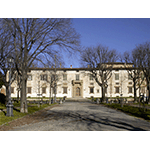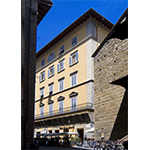Accademia della Crusca [Crusca Academy]
March 25, 1585, was the date of the inaugural ceremony of the Accademia della Crusca, whose origins are to be found in a number of meetings held between 1570 and 1580. In particular "the Cruscanti", whose emblem was the "shovel", were concerned with safeguarding and disseminating the fourteenth-century vulgar tongue, compiling a Vocabulary (published in one volume in Venice in 1612) which specified correct usage based on examples from the greatest authors of the time. The Vocabulary was the first lexigraphical work dedicated to a modern language. The Academy was included in the grand ducal political program, which had begun with the Accademia Fiorentina (founded in 1540) and continued with the Accademia degli Apatisti (founded in 1631), aimed at promoting Florentine as the official language for the dissemination of knowledge. The second edition of the Vocabulary was published in 1623, without any major changes in respect to the first edition.
The Academy’s contribution to defining scientific terminology was highly significant. In the third edition, printed in three volumes in Florence in 1691, outstanding figures in science, who had been members of the Accademia del Cimento (1657-1667), such as Carlo Roberto Dati, Francesco Redi and Lorenzo Magalotti participated. The latter, who had edited the Saggi di Naturali Esperienze fatte nell'Accademia del Cimento (assays of natural experiments made by the Accademia del Cimento) (Florence, 1666), adhered to the Tuscan literary tradition, enriched in particular by the high example of stylistic excellence offered by Galileo Galilei. The Saggi are cited in the Vocabulary as a linguistic text. Prince Leopold de' Medici, the chief promoter of the Accademia del Cimento and sponsor of the Crusca, also collaborated in the work, collecting many technical terms of the arts and trades that, for the first time, were included among the entries in the Vocabulary. The fourth edition of the Vocabulary was printed in Florence in six volumes in the years 1729 to 1738.
In 1783, at the initiative of Grand Duke Peter Leopold of Lorraine, the Accademia Fiorentina, the Accademia degli Apatisti and the Accademia della Crusca were combined to form the Second Florentine Academy, which launched its activity was a solemn assembly held at the Magliabechiana Library in the Uffizi Gallery on November 27, 1783. In 1808 the Imperial Council of Florence reformed the Academy, creating the Third Florentine Academy. Divided into three classes – the Societą del Cimento (which presided over the physical sciences and mathematics), the Societą della Crusca (which safeguarded the conservation of the purity of the Tuscan tongue as official language) and the Societą del Disegno (dedicated to promoting the fine arts and technology) – it continued to operate in this form until January 19, 1811, the year in which the Accademia della Crusca withdrew to form an independent institution.
In 1833, four committees were set up for the fifth edition of the Vocabolary; one of these was responsible for the scientific lexicon. The work, the first issue of which was published in 1843, continued for many years. In 1863 the first volume came out; in 1923 the work was suspended at the letter O. At this time profound changes occurred, which freed the Accademia from its strictly lexicographic commitment.
At present the Accademia della Crusca, organised in three centres of research (centre of studies in Italian philology, centre of studies in Italian lexicography, centre of studies in Italian grammar) is an institute of excellence that collaborates on important projects and carries out significant activities of research and consultation on the Italian language. It is headquartered in the historic Villa di Castello.
****************************
Texts by Graziano Magrini
English translation by Catherine Frost
Last update 26/mar/2008





